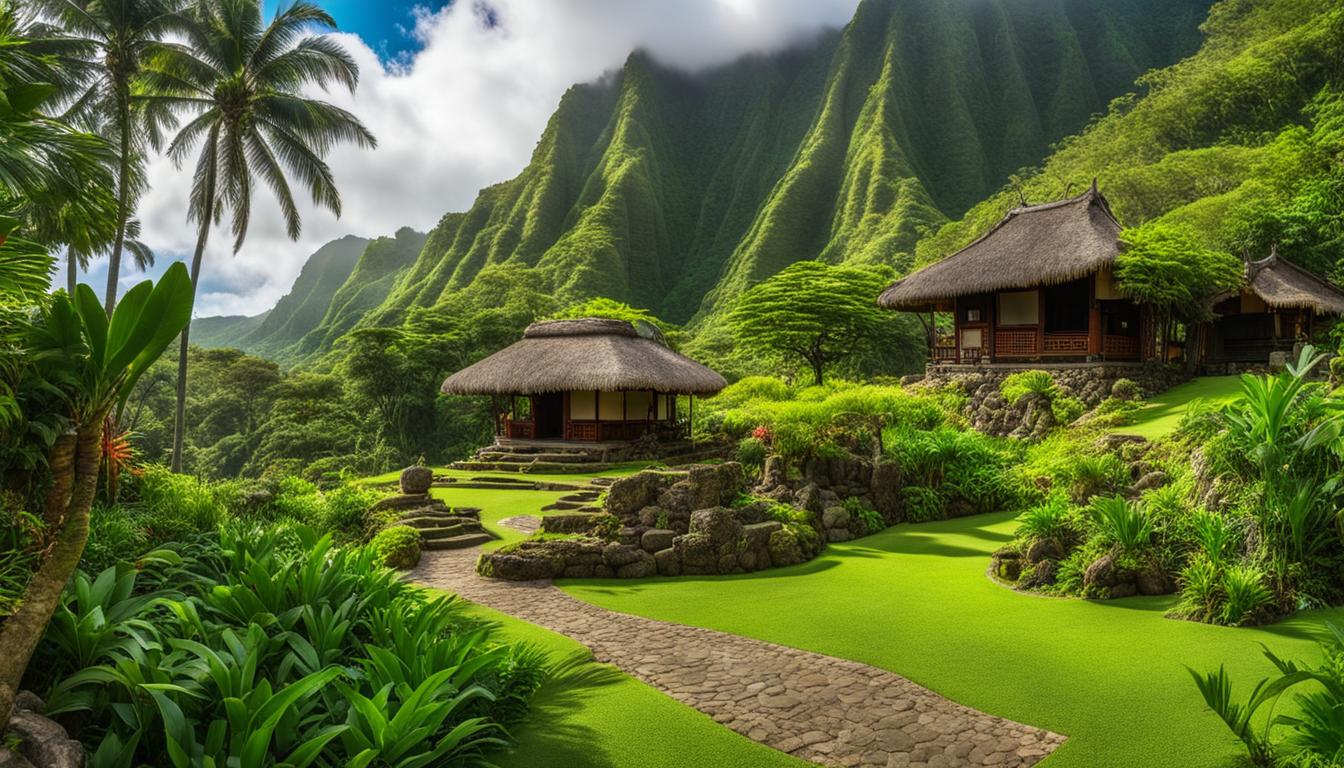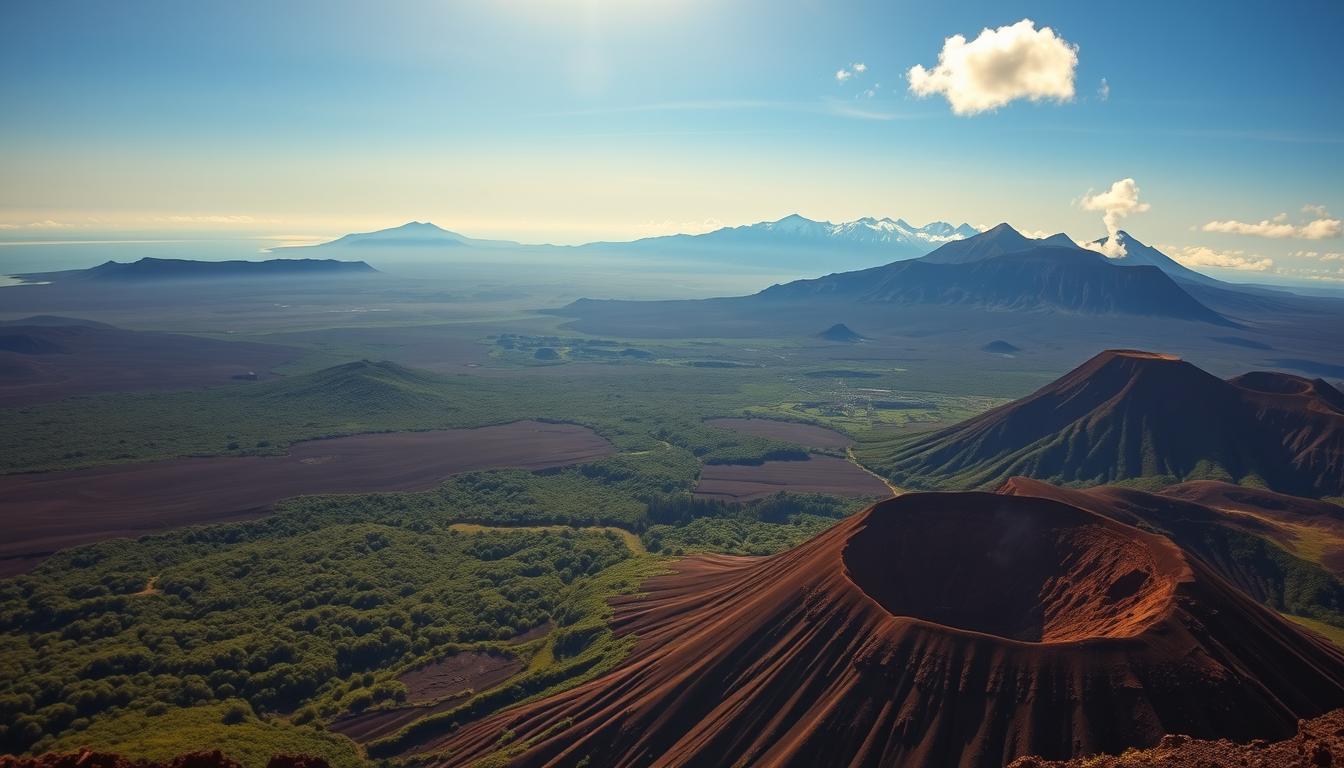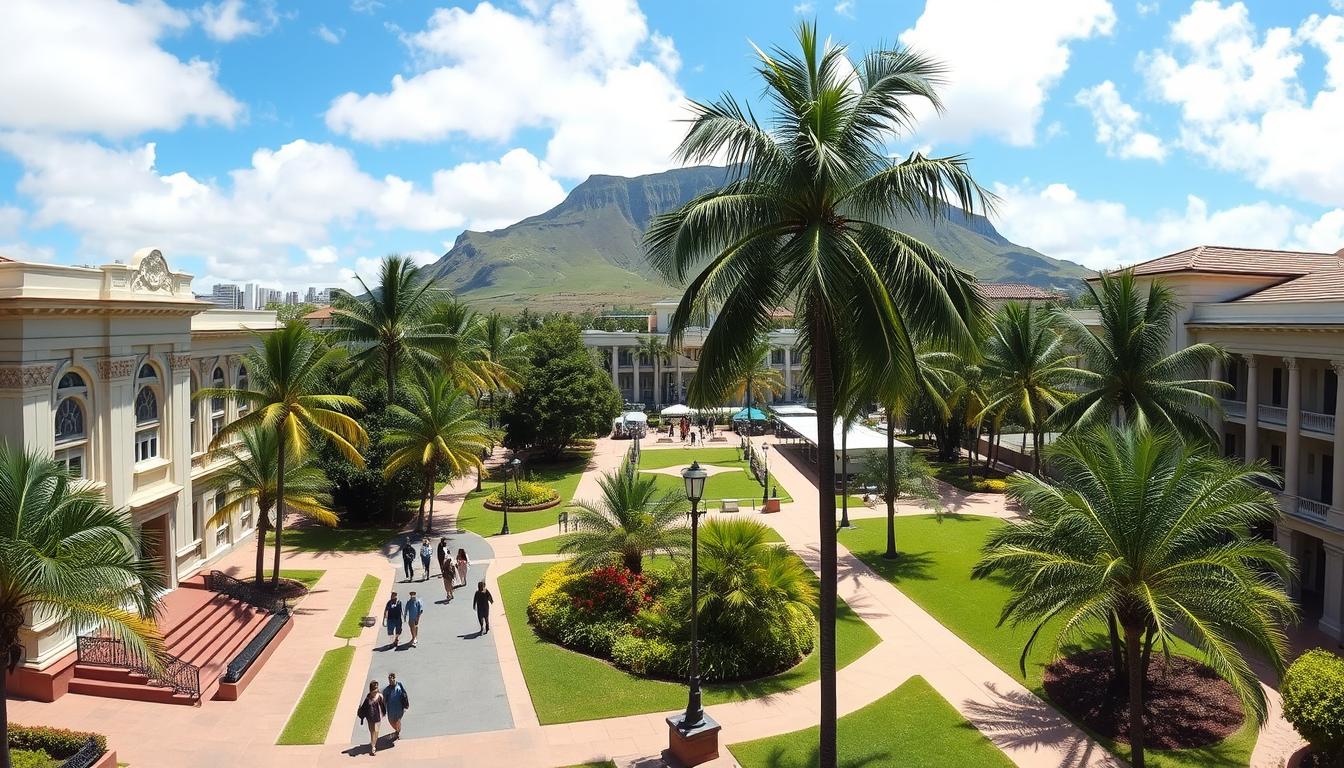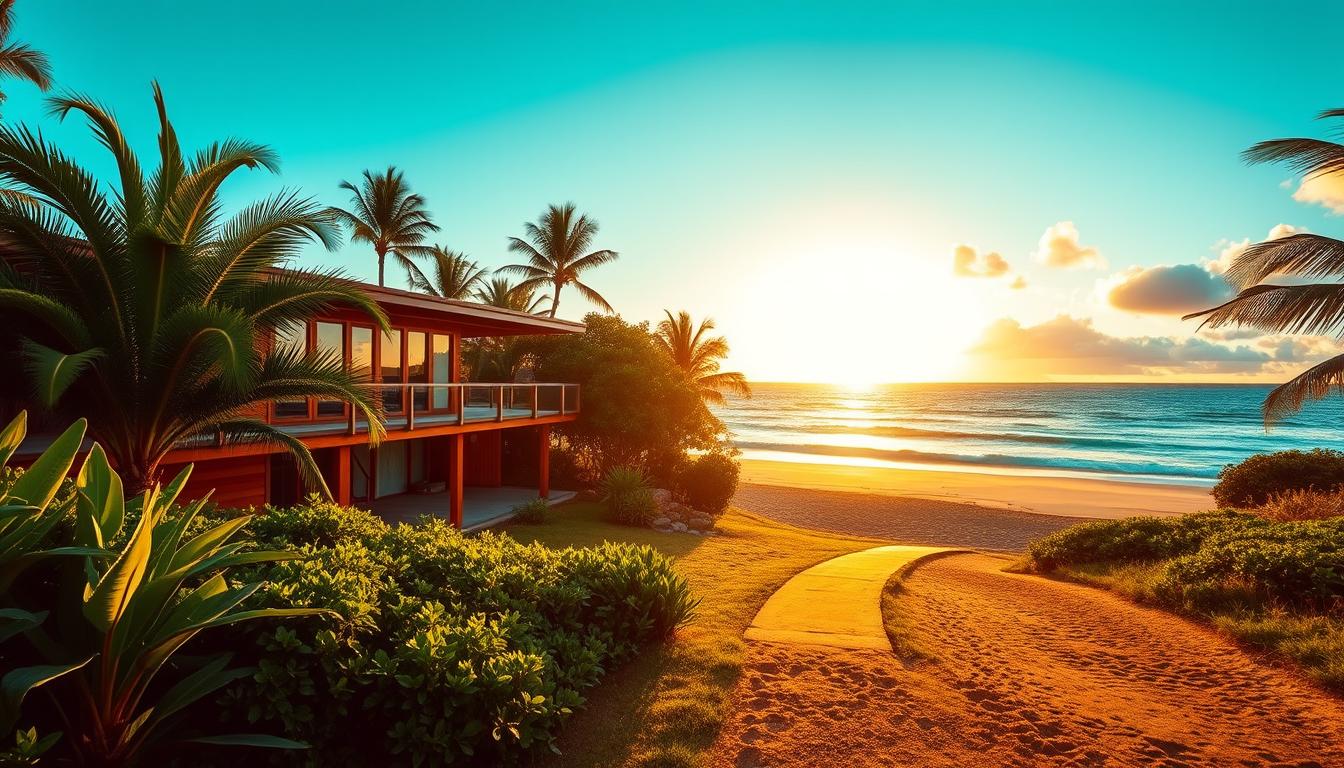Hawaii is a destination that offers much more than just stunning beaches and crystal-clear waters. It is also home to a rich history that is waiting to be discovered. From ancient Hawaiian temples to iconic landmarks that played significant roles in World War II, the historical sites and landmarks in Hawaii provide a fascinating journey through time.
Key Takeaways:
- Discover the unique blend of indigenous Hawaiian and colonial influences in Hawaii’s historical sites
- Visit must-see historical sites like Pearl Harbor National Memorial, Hawaii Volcanoes National Park, and Iolani Palace
- Learn about important historical events, such as World War II and the volcanic activity that shaped the islands
- Immerse yourself in the vibrant culture and rich heritage of Hawaii
- Experience the breathtaking natural beauty that surrounds these historical sites
Overview of Historic Sites in Hawaii
Hawaii, often referred to as the “Paradise of the Pacific,” is not only known for its stunning natural beauty but also for its rich history and cultural heritage. The islands are home to numerous historic sites that offer a glimpse into the past and showcase the unique blend of indigenous Hawaiian and colonial influences. Exploring these historic sites is a must for anyone looking to delve deeper into Hawaii’s fascinating history.
From sacred temples (heiaus) like Pu’u O Mahuka Heiau to iconic modern landmarks like the Pearl Harbor National Memorial, Hawaii boasts a diverse range of historical sites. These sites not only provide insight into significant historical events but also allow visitors to witness the breathtaking natural beauty that surrounds them. Whether you’re interested in learning about World War II at Pearl Harbor or exploring the volcanic activity that shaped the islands at Hawaii Volcanoes National Park, there is something for everyone.
When visiting historic sites in Hawaii, it’s important to respect and appreciate the cultural significance of these places. Many sites offer guided tours or informational displays that provide a deeper understanding of the history and traditions associated with each location. Take your time to explore these sites, immerse yourself in the stories they tell, and appreciate the rich tapestry of Hawaii’s past.
Table: Must-Visit Historic Sites in Hawaii
| Historic Site | Location | Description |
|---|---|---|
| Hawaii Volcanoes National Park | Big Island | Explore the volcanic landscapes and learn about the geological forces that continue to shape the islands. |
| Pearl Harbor National Memorial | Oahu | Pay tribute to the events of December 7, 1941, and learn about the impact of World War II on Hawaii. |
| Iolani Palace | Oahu | Visit the former royal residence of Hawaii and learn about the history of the Hawaiian monarchy. |
| Pu’uhonua o Honaunau National Historical Park | Big Island | Discover a place of refuge and learn about ancient Hawaiian traditions and customs. |
Exploring the historic sites of Hawaii is not only educational but also a chance to gain a deeper appreciation for the islands’ rich cultural heritage. Whether you’re interested in history, nature, or both, these sites offer a unique opportunity to experience the beauty and significance of Hawaii’s past.
Must-Visit Historical Sites in Hawaii
Hawaii is renowned for its rich history and vibrant culture, and there are several must-visit historical sites that offer a fascinating glimpse into the past. These famous landmarks in Hawaii not only provide educational insights into important historical events but also showcase the stunning natural beauty of the islands.
Hawaii Volcanoes National Park
One of the top historical attractions in Hawaii is the Hawaii Volcanoes National Park. This park allows visitors to witness the powerful forces of nature up close and personal. From exploring active volcanoes to traversing vast lava fields, this national park offers a truly awe-inspiring experience. Visitors can learn about the volcanic activity that has shaped the islands and witness the ongoing transformation of Hawaii’s landscape.
Pearl Harbor National Memorial
Another must-visit historical site in Hawaii is the Pearl Harbor National Memorial. This iconic landmark pays tribute to the events of December 7, 1941, when the Japanese launched a surprise attack on Pearl Harbor, marking the United States’ entry into World War II. Visitors can explore the memorial and learn about the history and significance of this pivotal moment in American history. The USS Arizona Memorial, where the sunken battleship remains, serves as a somber reminder of the lives lost during the attack.
Iolani Palace
Iolani Palace is a must-visit for those interested in Hawaii’s royal history. As the former official residence of the Hawaiian monarchy, this historic site offers a glimpse into the opulent world of Hawaii’s kings and queens. Visitors can take guided tours of the palace and explore the beautifully restored rooms, learning about the cultural heritage and political history of the islands.
| Historical Site | Location | Description |
|---|---|---|
| Hawaii Volcanoes National Park | Big Island | Explore active volcanoes and ancient lava fields |
| Pearl Harbor National Memorial | Oahu | Learn about the events of the Pearl Harbor attack |
| Iolani Palace | Oahu | Discover the former royal residence of the Hawaiian monarchy |
These must-visit historical sites in Hawaii offer a unique and immersive journey through the islands’ history and culture. From the raw power of volcanic activity to the solemn remembrance of significant events, these landmarks provide an enriching experience for visitors seeking to uncover the stories that have shaped Hawaii into the vibrant destination it is today.
Hawaii Volcanoes National Park – Witness the Power of Nature
A visit to Hawaii Volcanoes National Park is a thrilling journey into the raw power of nature. Located on the Big Island of Hawaii, this historical site showcases the volcanic activity that has shaped the islands over millions of years. The park is home to two active volcanoes, Kilauea and Mauna Loa, offering visitors a unique opportunity to witness live volcanic activity.
Exploring Hawaii Volcanoes National Park is like stepping into another world. Visitors can hike along trails that wind through ancient lava fields, marvel at lava tubes and caves, and even witness the mesmerizing glow of molten lava at Halema’uma’u Crater. The park also features stunning geological formations, such as the iconic Pu’u ‘O’o crater and the dramatic cliffs of the Chain of Craters Road.
Aside from its geological wonders, the park is also rich in cultural significance. It is home to sacred sites and petroglyphs that give insight into the ancient Hawaiian culture. Visitors can learn about the legends and stories associated with the volcanoes and gain a deeper understanding of the spiritual connection between the Hawaiians and their volcanic landscape.
Table: Comparison of Key Features at Hawaii Volcanoes National Park
| Feature | Kilauea | Mauna Loa |
|---|---|---|
| Volcanic Activity | Continuously active | Intermittently active |
| Hiking Trails | Multiple trails of varying difficulty | Backcountry trails for experienced hikers |
| Geological Formations | Pu’u ‘O’o crater, Kilauea Caldera | Chain of Craters Road, Mauna Loa summit |
| Cultural Sites | Halema’uma’u Crater, Pu’u Loa Petroglyphs | Puu Kapukapu, Holuku Petroglyphs |
Pearl Harbor National Memorial – A Tribute to History
Located in Honolulu, the Pearl Harbor National Memorial is a must-visit historical site that holds immense significance in American history. Built to commemorate the events of December 7, 1941, when the Japanese launched a surprise attack on Pearl Harbor, this memorial serves as a solemn tribute to the brave men and women who lost their lives that day, as well as those who served in the Pacific during World War II.
The centerpiece of the memorial is the USS Arizona Memorial, which spans the wreckage of the sunken battleship USS Arizona. Visitors can pay their respects to the fallen sailors and gain a deeper understanding of the events that unfolded on that fateful day through informative exhibits and a documentary film. The memorial also includes other historical sites, such as the USS Bowfin Submarine Museum and Park, the USS Oklahoma Memorial, and the Pacific Aviation Museum.
A visit to the Pearl Harbor National Memorial is not only educational but also deeply moving. It allows visitors to reflect on the sacrifices made by those who fought for freedom and offers a poignant reminder of the enduring impact of World War II on the United States and the world.
Table: Historical Sites in Hawaii
| Site | Location | Significance |
|---|---|---|
| Pearl Harbor National Memorial | Honolulu | Commemorates the events of the Pearl Harbor attack in 1941 |
| Hawaii Volcanoes National Park | Hawaii Island | Showcases the volcanic activity that shaped the islands |
| Iolani Palace | Honolulu | Former royal residence of Hawaii, symbolizing Hawaiian national identity |
| Pu’uhonua o Honaunau National Historical Park | Hawaii Island | Preserves ancient Hawaiian traditions and a place of refuge |
Exploring the Pearl Harbor National Memorial is an unforgettable experience that provides insight into the dramatic events of World War II and pays tribute to the courage and resilience of the individuals involved. It is a must-visit attraction for history enthusiasts, offering a profound educational experience and a chance to reflect on the impact of war on a global scale.
Iolani Palace – A Royal Residence Steeped in History
Immerse yourself in the opulent world of Hawaiian monarchy by visiting the iconic Iolani Palace. As the former official royal residence of Hawaii, it stands as a symbol of Hawaiian national identity and offers a fascinating glimpse into the island’s rich history. Located in Honolulu, this magnificent palace is a must-visit historical site for anyone interested in delving into Hawaii’s royal past.
Constructed in 1882, Iolani Palace served as the official residence of the Hawaiian monarchs, including King Kalakaua and his sister and successor, Queen Liliuokalani. The palace showcases a unique blend of architectural styles, combining European influences with traditional Hawaiian elements. From the opulent reception halls to the intricately designed throne room, each room within the palace tells a story of Hawaii’s royal heritage.
Visitors can explore the beautifully restored palace on guided tours led by knowledgeable docents or opt for self-led audio tours that provide fascinating insights into its rich past. The grandeur and elegance of Iolani Palace are truly captivating, transporting visitors back in time and offering a glimpse into the lives of Hawaiian royalty.
The Legacy of Iolani Palace
Iolani Palace holds a significant place in Hawaiian history as the only royal palace on American soil and as a testament to the resilience of the Hawaiian people. It served as the political and cultural center of the Kingdom of Hawaii, hosting lavish gatherings and diplomatic events, while also functioning as an important site for discussions on sovereignty and self-governance.
Today, Iolani Palace stands not only as a reminder of Hawaii’s royal past but also as a symbol of the ongoing efforts to preserve and honor the cultural heritage of the islands. It has been meticulously restored to its former glory, showcasing the grandeur and elegance of the Hawaiian monarchy.
| Visiting Information: | Details: |
|---|---|
| Address: | 364 South King Street, Honolulu, HI 96813 |
| Operating Hours: | Tuesday to Saturday, 9:00 AM – 4:00 PM |
| Admission: | Adults: $27.50, Children (5-12 years): $6 |
| Guided Tours: | Offered hourly from 9:00 AM to 3:00 PM |
Plan your visit to Iolani Palace and immerse yourself in the rich history and cultural heritage of Hawaii. Experience the grandeur of Hawaiian royalty and gain a deeper understanding of the island’s unique past. A visit to Iolani Palace is a journey through time that should not be missed.
Pu’uhonua o Honaunau National Historical Park – A Place of Refuge
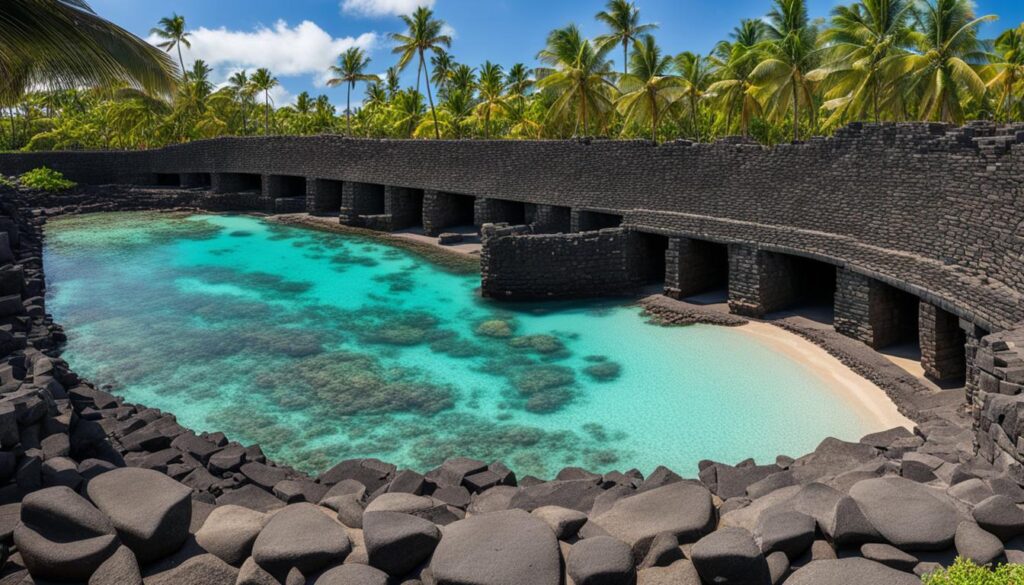
Located on the western coast of Hawaii’s Big Island, Pu’uhonua o Honaunau National Historical Park is a sacred site that offers a glimpse into ancient Hawaiian traditions and culture. The name “pu’uhonua” means a place of refuge, and this park served as a sanctuary for those who had broken a sacred law or sought safety during wartime.
Stepping into the park, visitors are transported back in time to a period when Hawaiian society was governed by strict kapu (taboos) and a complex set of laws. Within the grounds, you’ll find temples, ritual platforms, and an imposing 965-foot long wall that once encircled the area, providing protection and separating the sacred space from the outside world.
Exploring Pu’uhonua o Honaunau National Historical Park allows you to witness the unique architectural and cultural practices of the early Hawaiians. Marvel at the intricate carvings on the ki’i (wooden statues) and the beautifully preserved stone structures. Take a moment to reflect on the tranquility of the park, surrounded by the sounds of the ocean, lush vegetation, and the spiritual energy that still resonates within its borders.
As you wander through the park, you’ll come across informative plaques that provide insights into the historical and cultural significance of the site. Learn about the traditional Hawaiian practices, such as the kapu system, that shaped the daily lives of the people who sought refuge here. You’ll also have the opportunity to participate in cultural demonstrations and workshops, gaining a deeper understanding of the ancient traditions that continue to thrive in Hawaii today.
The Significance of Pu’uhonua o Honaunau National Historical Park
Pu’uhonua o Honaunau National Historical Park holds immense historical and cultural importance for the Hawaiian people. It not only serves as a tangible link to the past but also stands as a symbol of resilience, forgiveness, and the preservation of indigenous heritage.
Visiting this historical site allows you to connect with Hawaii’s rich history and gain a deeper appreciation for the traditions that have shaped the islands. Whether you’re interested in archaeology, Hawaiian spirituality, or simply immersing yourself in the natural beauty of the park, Pu’uhonua o Honaunau National Historical Park offers a captivating journey into the heart of Hawaiian culture.
Shangri La Museum of Islamic Art, Culture & Design – A Cultural Oasis
Immerse yourself in the rich Islamic traditions and art at the Shangri La Museum of Islamic Art, Culture & Design in Honolulu. This museum, once the home of American heiress and philanthropist Doris Duke, showcases over 3,500 objects from the Islamic world spanning centuries. From ceramics to textiles, metalwork to jewelry, the collection offers a glimpse into the diverse and vibrant Islamic culture. The museum is also known for its stunning setting overlooking the Pacific Ocean, providing a serene backdrop for appreciating the beauty and significance of Islamic art.
Exploring the Collections
Upon entering the Shangri La Museum, visitors are transported into a world of artistic wonder. The collections are thoughtfully curated to highlight the rich diversity of Islamic art, culture, and design. From exquisite calligraphy to intricate geometric patterns, each piece tells a story and reflects the creativity and craftsmanship of its time.
One notable exhibit is the Damascus Room, a stunning example of an 18th-century Syrian interior. The room’s intricately carved woodwork, colorful tilework, and beautiful textiles showcase the opulence and grandeur of the era. Visitors can step inside and imagine themselves in a bygone era, surrounded by the beauty of Islamic art.
Engaging Programs and Events
The museum offers a range of programs and events that further enrich the visitor experience. From guided tours to lectures and workshops, there are numerous opportunities to deepen one’s understanding of Islamic art and culture. The museum also hosts temporary exhibitions that showcase contemporary artists and their interpretations of Islamic art.
For those looking for a deeper dive into Islamic art, the museum’s research center provides access to a wealth of resources, including books, manuscripts, and archival materials. Scholars and researchers can explore these materials to further their studies and contribute to the understanding of Islamic art and culture.
| Opening Hours: | Tuesday – Saturday: 10am – 4:30pm |
|---|---|
| Address: | 4055 Papu Cir, Honolulu, HI 96816, United States |
| Contact: | Phone: +1 808-734-1941 |
| Admission: |
|
Kealakekua Bay State Historical Park – Where History Meets Conservation
Kealakekua Bay State Historical Park is a unique destination in Hawaii that seamlessly blends history and conservation. This historical site holds immense significance as the location of Captain James Cook’s arrival in Hawaii in 1779. It serves as a reminder of the cultural exchange and complex history between the Hawaiian people and the outside world. Today, the park is dedicated to marine life conservation and offers visitors an opportunity to explore both the historical and natural beauty of this stunning bay.
When visiting Kealakekua Bay State Historical Park, you’ll have the chance to learn about Captain James Cook’s encounter with the Hawaiian people and the impact it had on Hawaii’s history. The park provides a serene and picturesque setting, with crystal-clear waters and lush landscapes that create a peaceful atmosphere. Visitors can engage in activities such as snorkeling, kayaking, or taking guided tours to fully immerse themselves in the beauty of the bay.
What sets Kealakekua Bay State Historical Park apart is its commitment to conservation. The park aims to protect the sensitive marine ecosystem and educate visitors about the importance of preserving Hawaii’s natural resources. By exploring the bay responsibly and following designated guidelines, visitors can contribute to the ongoing conservation efforts and help ensure the beauty and biodiversity of Kealakekua Bay for future generations.
Activities and Attractions at Kealakekua Bay State Historical Park
| Activities | Attractions |
|---|---|
|
|
Whether you’re interested in history, conservation, or simply enjoying the beauty of nature, Kealakekua Bay State Historical Park has something to offer. It’s a place where you can gain insights into Hawaii’s past while also appreciating its present natural wonders. Soak in the rich history, explore the marine life, and be part of the ongoing efforts to preserve this remarkable bay.
Lyman Mission House and Museum – Preserving Hawaii’s Past
The Lyman Mission House and Museum is a significant historical site in Hawaii that plays a crucial role in preserving the rich heritage of the islands. Situated in Hilo, this museum offers a captivating journey into Hawaii’s past, allowing visitors to immerse themselves in the volcanic origins, diverse fauna and flora, and the lives of early settlers. With its compelling exhibits, artifacts, and guided tours, the Lyman Mission House and Museum provides a comprehensive understanding of Hawaii’s history and the impact of missionaries on the islands’ cultural development.
The mission house, built in the 1830s, served as a residence for the Christian missionaries who came to Hawaii to spread their beliefs. Today, it stands as a testament to their dedication and offers a glimpse into the challenges they faced and the legacy they left behind. The museum showcases an extensive collection of historical artifacts, including tools, furnishings, and personal belongings, shedding light on the daily lives of both the missionaries and the Hawaiian people.
Visitors to the Lyman Mission House and Museum can expect a captivating experience that combines education and immersion. The guided tours provide valuable insights into the lives of the early settlers and the cultural exchange that took place between them and the native Hawaiians. The exhibits highlight the interconnectedness of Hawaiian history with the global events of the time, such as the whaling industry, the growth of sugar plantations, and the impact of Western influences.
| Highlights of the Lyman Mission House and Museum: |
|---|
| An array of historical artifacts, including tools, furnishings, and personal belongings |
| Guided tours providing insights into the lives of early settlers and the cultural exchange |
| Exhibits showcasing the interconnectedness of Hawaiian history with global events |
| An opportunity to explore the volcanic origins and diverse flora and fauna of Hawaii |
For those seeking a deeper understanding of Hawaii’s past, the Lyman Mission House and Museum is a must-visit destination. It offers a unique perspective on the historical development of the islands and the significant role played by missionaries in shaping Hawaii’s culture. From the volcanic origins of the islands to the cultural exchange between different communities, this museum provides a comprehensive and enlightening experience for visitors of all ages.
Puukohola Heiau National Historical Site – An Ancient Symbol of Unity
Immerse yourself in the rich cultural and historical significance of Puukohola Heiau National Historical Site. Located on the island of Hawaii, this ancient temple holds a profound place in Hawaiian history. It was built by King Kamehameha as a symbol of peace and unity, with the aim of uniting the Hawaiian Islands under one rule. The temple’s impressive size and intricate construction reflect the power dynamics and spirituality of ancient Hawaiian society.
Exploring Puukohola Heiau, visitors have the opportunity to delve into Hawaiian traditions and gain insight into the island’s past. The site’s ruins stand as a testament to the strength and resilience of the Hawaiian people. The natural beauty surrounding the temple, from lush vegetation to stunning sea cliffs, adds to the overall experience of visiting this historical site.
For history enthusiasts and those seeking a deeper understanding of Hawaiian culture, Puukohola Heiau National Historical Site is a must-visit destination. Witness the historical and cultural significance of this ancient symbol of unity while immersing yourself in the natural beauty that Hawaii has to offer.
Table: Comparison of Historical Attractions in Hawaii
| Historical Site | Location | Historical Significance | Natural Beauty |
|---|---|---|---|
| Puukohola Heiau National Historical Site | Island of Hawaii | Ancient temple symbolizing unity | Lush vegetation and stunning sea cliffs |
| Pearl Harbor National Memorial | Oahu | Commemorates the events of the Pearl Harbor attack | Scenic harbor views and naval artifacts |
| Iolani Palace | Oahu | Former royal residence of Hawaii | Architectural beauty and historic gardens |
| Hawaii Volcanoes National Park | Island of Hawaii | Showcases volcanic activity and unique landscapes | Active volcanoes, lava fields, and diverse flora |
Kukaniloko Birthstone State Monument – A Place of Birth and Ancient Traditions
Immerse yourself in the profound cultural significance of the Kukaniloko Birthstone State Monument, one of Hawaii’s hidden historical gems. This sacred site holds a deep connection to ancient Hawaiian traditions and beliefs surrounding childbirth. It was once a revered birthing place for Hawaiian royalty, and the 180 lava-rock stones that remain today are believed to possess powerful healing energies.
Visiting the Kukaniloko Birthstone State Monument offers a unique opportunity to learn about the sacred rituals and traditions associated with childbirth in ancient Hawaii. As you explore the site, you’ll marvel at the age and significance of these 900-year-old stones, which have witnessed the birth of generations of Hawaiian royalty.
The Kukaniloko Birthstone State Monument is not just a historical landmark; it is a place where history and culture intertwine. It provides a tranquil and awe-inspiring atmosphere for visitors to connect with the deep-rooted traditions and values of the Hawaiian people. A visit to this remarkable site is a chance to gain a deeper understanding of Hawaii’s rich cultural heritage and the importance of family and tradition in ancient Hawaiian society.
FAQ
What are some must-visit historical sites in Hawaii?
Some must-visit historical sites in Hawaii include Pearl Harbor National Memorial, Hawaii Volcanoes National Park, Iolani Palace, and Pu’uhonua o Honaunau National Historical Park.
What can I learn at Pearl Harbor National Memorial?
Pearl Harbor National Memorial offers the opportunity to learn about the events of December 7, 1941, when the Japanese launched a surprise attack on Pearl Harbor, leading to the United States’ entry into World War II.
What is the significance of Iolani Palace?
Iolani Palace served as the former official royal residence of Hawaii and holds a significant place in the island’s history as a symbol of Hawaiian national identity.
What does Hawaii Volcanoes National Park offer visitors?
Hawaii Volcanoes National Park offers the opportunity to witness firsthand the volcanic activity that has shaped the islands over millions of years, with highlights such as live magma at Halema’uma’u Crater and expansive lava fields.
What can I experience at Pu’uhonua o Honaunau National Historical Park?
Pu’uhonua o Honaunau National Historical Park allows visitors to explore sacred temples, ancient fishponds, and petroglyphs while immersing themselves in the natural beauty of the park.
What can I find at the Shangri La Museum of Islamic Art, Culture & Design?
The Shangri La Museum of Islamic Art, Culture & Design showcases over 3,500 objects from the Islamic world, including ceramics, textiles, metalwork, and jewelry, offering a glimpse into the diverse and vibrant Islamic culture.
What is the historical significance of Kealakekua Bay State Historical Park?
Kealakekua Bay State Historical Park is the site of Captain James Cook’s arrival in Hawaii and now dedicated to marine life conservation. Visitors can learn about Cook’s encounter with the Hawaiian people and witness the natural beauty of the bay.
What can I learn at the Lyman Mission House and Museum?
The Lyman Mission House and Museum provides insights into the volcanic origins of the islands, the diverse fauna and flora, and the lives of early settlers in Hawaii during the 19th and 20th centuries.
What is the significance of Puukohola Heiau National Historical Site?
Puukohola Heiau National Historical Site is an ancient Hawaiian temple built by King Kamehameha as a symbol of peace and unity, offering visitors insight into Hawaiian traditions and power dynamics that shaped the islands.
What can I discover at Kukaniloko Birthstone State Monument?
Kukaniloko Birthstone State Monument was once used as a royal birthing place and offers a unique perspective on ancient Hawaiian traditions and the sacredness of birth.

Scott Sweeney is the creator of Virtual Hawaii 360. Scott is a professional marketer and a lifelong Hawaii enthusiast. Scott splits time between Oahu and Dayton, Ohio. In addition to his marketing endevours, he is also a published Ukulele musician.

